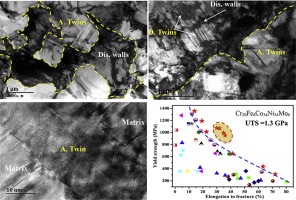当前位置:
X-MOL 学术
›
Int. J. Plasticity
›
论文详情
Our official English website, www.x-mol.net, welcomes your
feedback! (Note: you will need to create a separate account there.)
Strength and Ductility of CrFeCoNiMo Alloy with Hierarchical Microstructures
International Journal of Plasticity ( IF 9.4 ) Pub Date : 2019-02-01 , DOI: 10.1016/j.ijplas.2018.10.005 Kaisheng Ming , Xiaofang Bi , Jian Wang
International Journal of Plasticity ( IF 9.4 ) Pub Date : 2019-02-01 , DOI: 10.1016/j.ijplas.2018.10.005 Kaisheng Ming , Xiaofang Bi , Jian Wang

|
Abstract Single-phase multi-principal-element alloys (MPEAs) with face-centered cubic (FCC) structure generally exhibit low yield strength but superb ductility and strain hardening capability. In this work, we demonstrate that enhancing yield strength while retaining good ductility of single phase FCC MPEAs can be achieved by developing hierarchical microstructures. A non-equiatomic Cr20Fe6Co34Ni34Mo6 alloy with single-phase FCC structure was fabricated and immediately cold-rolled with ∼70% thickness reduction after a liquid nitrogen bath. The cold-rolled sample was then annealed at various temperatures in a range of 675–1150 °C for various periods. As annealing temperature exceeds 800 °C, annealed samples exhibit coarse-grained microstructure and low yield strength, while high strain hardening rate and good ductility. As annealing temperature is lower than 800 °C, annealed samples develop hierarchical microstructures that comprise high density of annealing nano-twins in recrystallized fine grains (grain size ∼ 1 μm) and stable dislocation walls in non-fully recrystallized fine grains. The addition of Mo in the system is found to be very effective in retarding the recrystallization and grain growth, promoting formation of recrystallized fine grains. Mechanical tensile testing reveals that such kind of hierarchical microstructure enhances yield strength of single phase FCC MPEAs (1.1 GPa) while retains good ductility (uniform elongation of ∼29%) and high ultimate tensile strength (1.3 GPa). Grain boundaries, twin boundaries and dislocation walls act as strong barriers for dislocation motion, enhancing yield strength and strain hardening capacity. Dislocation walls also act as sources for dislocations and deformation twins at large deformation stages, retaining a good ductility. Engineering such hierarchical microstructures should thus be an efficient strategy in enhancing mechanical properties of FCC MPEAs with low or medium stacking fault energies.
中文翻译:

具有分级显微组织的 CrFeCoNiMo 合金的强度和延展性
摘要 具有面心立方(FCC)结构的单相多主元素合金(MPEA)通常表现出较低的屈服强度,但具有极好的延展性和应变硬化能力。在这项工作中,我们证明了通过开发分层微观结构可以提高屈服强度,同时保持单相 FCC MPEA 的良好延展性。制备了具有单相 FCC 结构的非等原子 Cr20Fe6Co34Ni34Mo6 合金,并在液氮浴后立即冷轧,厚度减少 70%。然后将冷轧样品在 675-1150°C 范围内的不同温度下退火不同时间。当退火温度超过800℃时,退火样品呈现出粗晶组织和低屈服强度,同时具有高应变硬化率和良好的延展性。当退火温度低于 800 °C 时,退火样品会形成分层微观结构,包括再结晶细晶粒(晶粒尺寸 ∼ 1 μm)中的高密度退火纳米孪晶和非完全再结晶细晶粒中的稳定位错壁。发现在体系中添加 Mo 可以非常有效地阻止再结晶和晶粒生长,促进再结晶细晶粒的形成。机械拉伸测试表明,这种分层微观结构提高了单相 FCC MPEAs 的屈服强度(1.1 GPa),同时保持了良好的延展性(均匀伸长率为 ~29%)和高极限拉伸强度(1.3 GPa)。晶界、孪晶界和位错壁作为位错运动的强大屏障,增强了屈服强度和应变硬化能力。位错壁在大变形阶段也作为位错和变形孪晶的来源,保持良好的延展性。因此,设计这种分层微结构应该是提高具有低或中等堆垛层错能的 FCC MPEA 机械性能的有效策略。
更新日期:2019-02-01
中文翻译:

具有分级显微组织的 CrFeCoNiMo 合金的强度和延展性
摘要 具有面心立方(FCC)结构的单相多主元素合金(MPEA)通常表现出较低的屈服强度,但具有极好的延展性和应变硬化能力。在这项工作中,我们证明了通过开发分层微观结构可以提高屈服强度,同时保持单相 FCC MPEA 的良好延展性。制备了具有单相 FCC 结构的非等原子 Cr20Fe6Co34Ni34Mo6 合金,并在液氮浴后立即冷轧,厚度减少 70%。然后将冷轧样品在 675-1150°C 范围内的不同温度下退火不同时间。当退火温度超过800℃时,退火样品呈现出粗晶组织和低屈服强度,同时具有高应变硬化率和良好的延展性。当退火温度低于 800 °C 时,退火样品会形成分层微观结构,包括再结晶细晶粒(晶粒尺寸 ∼ 1 μm)中的高密度退火纳米孪晶和非完全再结晶细晶粒中的稳定位错壁。发现在体系中添加 Mo 可以非常有效地阻止再结晶和晶粒生长,促进再结晶细晶粒的形成。机械拉伸测试表明,这种分层微观结构提高了单相 FCC MPEAs 的屈服强度(1.1 GPa),同时保持了良好的延展性(均匀伸长率为 ~29%)和高极限拉伸强度(1.3 GPa)。晶界、孪晶界和位错壁作为位错运动的强大屏障,增强了屈服强度和应变硬化能力。位错壁在大变形阶段也作为位错和变形孪晶的来源,保持良好的延展性。因此,设计这种分层微结构应该是提高具有低或中等堆垛层错能的 FCC MPEA 机械性能的有效策略。











































 京公网安备 11010802027423号
京公网安备 11010802027423号